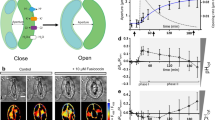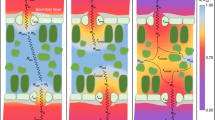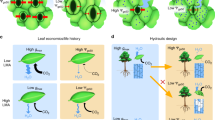Abstract
STOMATAL movements are brought about by differential changes in turgor pressure between guard cells and other epidermal cells1,2. The mechanism by which the turgor changes occur has been investigated for well over a century and a number of hypotheses have been proposed but none has been found to be completely satisfactory. Research in recent years has provided increasing evidence that active ion transport plays a major role in the stomatal mechanism3–6. It has been shown that, as stomata open, certain ions move into the guard cells and that this ion influx may be a dominant factor in raising the guard cell osmotic concentration. As a result, water enters the guard cells and brings about the opening movement. During closure of stomata the process seems to reverse whereby ions are lost by the guard cells. Cl− and K+ seem to be the major ions involved in the stomatal mechanism4,6–10.
This is a preview of subscription content, access via your institution
Access options
Subscribe to this journal
Receive 51 print issues and online access
$199.00 per year
only $3.90 per issue
Buy this article
- Purchase on Springer Link
- Instant access to full article PDF
Prices may be subject to local taxes which are calculated during checkout
Similar content being viewed by others
References
Von Mohl, H., Bot. Zbl., 14, 697–704 (1856).
Heath, O. V. S., New Phytol, 37, 385–395 (1938).
Fujino, M., Sci. Bull. Fac. Educ. Nagasaki Univ., 18, 1–47 (1967).
Fischer, R., Science, 160, 784–785 (1968).
Humble, G. D., and Hsiao, T. C., Pl. Physiol., Lancaster, 44, 230–234 (1969).
Willmer, C. M., and Mansfield, T. A., New Phytol., 69, 639–645 (1970).
Imamura, S., Jap. J. Bot., 12, 251–346 (1943).
Yamashita, T., Sieboldia, 1, 51–70 (1952).
Fujino, M., Kagaku (Jap.), 29, 147–148 (1959).
Humble, G. D., and Raschke, K., Pl. Physiol., Lancaster, 48, 447–453 (1971).
Raschke, K., and Fellows, M. P., Planta, 101, 296–316 (1971).
Satter, R. L., Marinoff, P., and Galston, A. W., Am. J. Bot., 57, 916–926 (1970).
Willmer, C. M., and Pallas, J. E., jun., Can. J. Bot., 51, 37–42 (1973).
Willmer, C. M., Pallas, J. E., jun., and Black, C. C., jun., Pl. Physiol., Lancaster, 52, 448–452 (1973).
Author information
Authors and Affiliations
Rights and permissions
About this article
Cite this article
WILLMER, C., PALLAS, J. Stomatal movements and ion fluxes within epidermis of Commelina communis L.. Nature 252, 126–127 (1974). https://doi.org/10.1038/252126a0
Received:
Issue Date:
DOI: https://doi.org/10.1038/252126a0
This article is cited by
-
Drought-induced H2O2 accumulation in subsidiary cells is involved in regulatory signaling of stomatal closure in maize leaves
Planta (2013)
-
Cellular osmotic phenomena during stomatal movements ofCommelina communis
Protoplasma (1978)
-
New structure associated with stomatal complex of the fern Polypodium vulgare
Nature (1977)
-
Active chloride transport in the leaf epidermis of Commelina communis in relation to stomatal activity
Planta (1976)
-
Some new observations and interpretations on the vital staining of leaf epidermal tissue by neutral red
Protoplasma (1976)
Comments
By submitting a comment you agree to abide by our Terms and Community Guidelines. If you find something abusive or that does not comply with our terms or guidelines please flag it as inappropriate.



